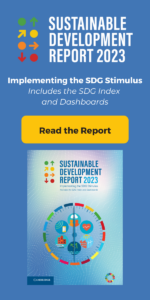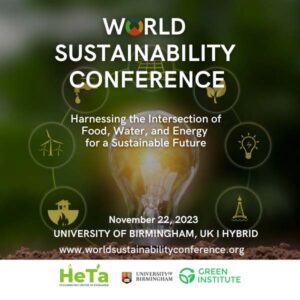The need for massive carbon dioxide removal
Removing atmospheric CO2 is essential to achieving the 1.5°C goal formulated in Paris. However, the main technologies under development are unlikely to sequester carbon dioxide at the massive scale required. We need to urgently explore new avenues, and invest particularly in ocean-based solutions
Climate — Global

The Intergovernmental Panel on Climate Change (IPCC) tells us that unless we keep global average temperatures within 1.5°C of pre-industrial conditions, catastrophic climate impacts will occur. We are now around 1.1°C, and we already see unprecedented heatwaves, wildfires, intense precipitation, and other impacts, all leading to a large loss of life and massive property damage. Staying within 1.5°C is now generally acknowledged to require net-zero greenhouse gas (GHG) emissions by about 2050.
All agree that the top priority is reducing fossil fuel emissions. However, that will not be enough. Complete elimination of GHG emissions seems impossible. The world cannot completely decarbonize. Some industrial and transportation activities will still emit GHGs. Not all electricity generation everywhere in the world will move to renewables or nuclear by 2050. Much agricultural activity (including livestock) emits GHGs that are difficult to completely eliminate. Moreover, as the world continues to warm, there will be more wildfires, which are a rapidly growing source of GHGs and are nullifying many efforts to reduce fossil fuel emissions. Some important natural sinks of GHGs, most notably the Amazon rainforest, appear to be losing much of their ability to counteract GHG emissions.
Therefore, net-zero emissions will likely require the removal of a considerable amount of carbon dioxide from the atmosphere. The IPCC has repeatedly insisted that large-scale carbon dioxide removal (CDR) is needed to stay within the 1.5°C goal. It did so in its 2018 report on the importance of staying within 1.5°C and in the Sixth Assessment Report of 2021. Removing carbon dioxide from the atmosphere would help to:
- make up for a fraction of the current inadequacy of decarbonization efforts;
- neutralize the residual emissions (for example, from agriculture) that would occur even if fossil fuel use were virtually eliminated;
- correct overshoots (the almost certain exceedance of carbon budgets until adequate GHG emission reductions are achieved);
- in the long term, stabilize the climate by moving us from our current levels (about 412 parts per million of CO2) closer to a more desirable level, possibly around 350 ppm.
Technological options
Several technologies have been discussed to remove carbon dioxide from the atmosphere. Three of the most prominent of these are:
- bioenergy with carbon capture and storage (BECCS) – burning biomass; capturing and storing or utilizing the generated CO2; and utilizing the produced energy;
- afforestation and reforestation (AF/RF) – planting new forests on lands that have historically not contained forests, or on lands that had previously been forests but that had been converted to other uses;
- direct air capture and storage (DACS) – chemical process by which carbon dioxide is captured directly from the ambient air, with subsequent storage.
All three of these approaches have great potential but also major limitations. BECCS has never been deployed at a commercial scale, and it requires growing an enormous quantity of biomass so that it can be burned, utilizing vast amounts of land. AF/RF requires a large amount of land to grow trees. Both BECCS and AF/RF would potentially need to take over huge amounts of acreage now used for agriculture, thereby reducing food supply and increasing food prices – problems that climate change will make worse because of higher temperatures, drought, spread of pests, and other impacts. How all this land would be acquired, and who would pay whom to acquire it, are unresolved. BECCS also requires large inputs of water and fertilizer, which in turn require large inputs of natural gas or mined ores (for example, phosphate). BECCS also demands considerable energy inputs.
Direct air capture is promising, but it has not yet been demonstrated at scale. The largest DAC plant in the world opened in Iceland in September 2021, promising to capture 4,000 metric tons per year of carbon dioxide. Human activities generate about 43 billion metric tons per year of carbon dioxide, so around 10 million such plants would be needed to absorb such emissions. The cost of DAC has been estimated anywhere from a little below USD 100 per ton to USD 1,000 per ton. Of course, as the technology develops, the scale of units should go way up and the price should go way down, and the emissions that need to be absorbed should drop considerably, but the challenge remains formidable.
For all these reasons – especially the demand for land, water, and energy – there are real limitations on the amount of CDR that can be achieved on the planet without itself causing severe environmental and human disruption. BECCS and DACS also involve great technological uncertainty.
CDR 2.0
In sum, we do not know if BECCS, AF/RF, and DACS, or even all in combination, would be able to achieve carbon dioxide removal at the enormous scale necessary, and at a bearable environmental and economic cost. Therefore, while we explore these techniques, we have to look for additional options for CDR.
Several of the additional options involve the use of the oceans. They have virtually unlimited capacity to store carbon dioxide. Their use would avoid conflicts over competing uses of land, and would not be as subject to not-in-my-backyard opposition as land-based methods. Some of the techniques could reduce ocean acidification – the evil twin of climate change. Among the options at the early stages of development are:
- artificial upwelling and downwelling
- electrochemical ocean CDR
- seaweed cultivation
- iron, nitrogen, and phosphorus fertilization
- ocean alkalinity enhancement
Each of these has its own technical and environmental challenges. But the urgency of removing carbon dioxide from the atmosphere while slashing fossil fuel emissions at a mind-boggling scale, compel rapid progress with research and development. Hopefully this work will show that some of these CDR technologies will be effective, economical, and environmentally acceptable, and can be deployed at the necessary scale.







